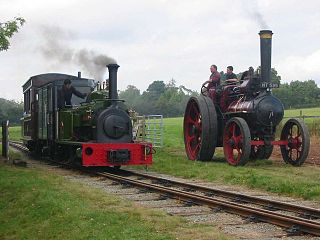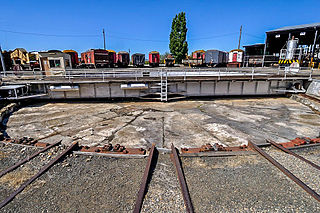 | |
 | |
| Established | 2005 |
|---|---|
| Location | Cline Town, Freetown, Sierra Leone |
| Type | Rail museum |
| Website | National Railway Museum |
The National Railway Museum is a railway museum in Freetown, Sierra Leone. The museum was opened in 2005.
 | |
 | |
| Established | 2005 |
|---|---|
| Location | Cline Town, Freetown, Sierra Leone |
| Type | Rail museum |
| Website | National Railway Museum |
The National Railway Museum is a railway museum in Freetown, Sierra Leone. The museum was opened in 2005.
The Sierra Leone Government Railway closed in 1974. A collection of rolling stock was retained at the former railway workshops to form a museum. Locos included one of the 4-8-2+2-8-4 Garratts, a Hunslet tank, and a couple of the diesel locos. Several coaches were also kept, including the Governor's coach, and a coach specially prepared for the visit of Queen Elizabeth II in 1961. [1]
Through the years of civil strife and war this collection disappeared from sight and it was feared it had been destroyed. However the collection survived despite the workshops being used as a centre for displaced persons. Following the initiative of a British army officer, Colonel Steve Davies, restoration of the equipment commenced in 2004. [2] [3]
The former President of the Republic of Sierra Leone, Alhaji Dr. Ahmad Tejan Kabbah, visited the workshops site and indicated his support for preserving the railway heritage of Sierra Leone and opening the museum. The Sierra Leone National Railway Museum opened in Cline Town in 2005. [4]
The museum is open 10am-4pm Monday to Saturday. The museum is supported by Friends of the Sierra Leone National Railway Museum, based in the UK. [5] In addition to the various preserved locomotives and carriages, there are numerous displays of old photographs, tickets, maps and time tables. Entry to the museum is free, however, visitors are encouraged to make a donation towards its upkeep. [6]

The National Railway Museum (NRM) is a museum in York, England, forming part of the Science Museum Group. The museum tells the story of rail transport in Britain and its impact on society. It is the home of the national collection of historically significant railway vehicles such as Mallard, Stirling Single, Duchess of Hamilton and a Japanese bullet train. In addition, the National Railway Museum holds a diverse collection of other objects, from a household recipe book used in George Stephenson's house to film showing a "never-stop railway" developed for the British Empire Exhibition. It has won many awards, including the European Museum of the Year Award in 2001.

The Great Central Railway (GCR) is a heritage railway in Leicestershire, England, named after the company that originally built this stretch of railway. It runs for 8.25 miles (13.28 km) between the town of Loughborough and a new terminus in the north of Leicester. It has period signalling, locomotives and rolling stock.

The Tanfield Railway is a 4 ft 8+1⁄2 instandard gauge heritage railway in Gateshead and County Durham, England. Running on part of a former horse-drawn colliery wooden waggonway, later rope & horse, lastly rope & loco railway. It operates preserved industrial steam locomotives. The railway operates a passenger service every Sunday, plus other days, as well as occasional demonstration coal, goods and mixed trains. The line runs 3 miles (4.8 km) between a southern terminus at East Tanfield, Durham, to a northern terminus at Sunniside, Gateshead. Another station, Andrews House, is situated near the Marley Hill engine shed. A halt also serves the historic site of the Causey Arch. The railway claims it is "the world's oldest railway" because it runs on a section dating from 1725, other parts being in use since 1621.

The Birmingham Railway Carriage and Wagon Company (BRC&W) was a railway locomotive and carriage builder, founded in Birmingham, England and, for most of its existence, located at nearby Smethwick, with the factory divided by the boundary between the two places. The company was established in 1854.

The Nene Valley Railway (NVR) is a preserved railway in Cambridgeshire, England, running between Peterborough Nene Valley and Yarwell Junction. The line is 7+1⁄2 miles (12.1 km) in length. There are stations at each terminus, and three stops en route: Orton Mere, Overton and Wansford.

The Ribble Steam Railway is a standard gauge preserved railway in Lancashire, in the United Kingdom. It was opened to the public on 17 September 2005, running along Preston Docks. The railway began by housing much of the collection from the previously closed Southport Railway Museum (Steamport), which was based in the old Lancashire and Yorkshire Railway engine shed at Southport.

The Churnet Valley Railway is a preserved standard gauge heritage railway in the Staffordshire Moorlands of Staffordshire, England. It operates on part of the former Churnet Valley Line which was opened by the North Staffordshire Railway. The railway is roughly 10.5 miles (16.9 km) long from Kingsley and Froghall to Ipstones. The land from Leek Brook Junction to Ipstones was opened by Moorland & City Railways (MCR) in 2010 after they took a lease out from Network Rail. This has subsequently been purchased by the Churnet Valley Railway. The main stations along the line are Kingsley and Froghall, Consall, Cheddleton and Leek Brook. Work has begun to extend the line to the town of Leek which will act as the northern terminus of the line. The line between Leek and Waterhouses has also been reopened as part of the heritage railway as far as Ipstones.

The West Lancashire Light Railway (WLLR) is a 2 ft narrow gauge railway that operates at Hesketh Bank, situated between Preston and Southport in North West England. The distance between the stations on the railway is 430 yards (393 m), though track extends eastwards beyond Delph station on ledge above the old clay pit which is too narrow to contain a run round loop. An extension of up to 435 metres (1,427 ft), running along the north bank of the fishing lake has been proposed. The railway has seven steam locomotives, three of which are in operating condition; two are currently being rebuilt and another is on static display. There are also two electric locomotives and many IC locomotives.

The Electric Railway Museum was located in Warwickshire, south-east of Coventry, near the village of Baginton. The heritage railway centre was immediately adjacent to Coventry Airport and so it was also known as "The Airfield Line". The site was managed by the Electric Railway Museum Limited, and was home to a sizeable collection of preserved electric multiple units (EMUs), which was the most diverse and historically significant collection of EMUs in the UK, containing unique items that are the last survivors of once typical and numerous classes. In addition, there were small industrial electric locomotives, two small industrial diesel locomotives, and one small industrial petrol locomotive, along with some other railway vehicles, which are owned by third parties. The land was leased from Coventry City Council, though it is located just outside the city boundary and is in the county of Warwickshire.

Locomotion, previously known as Locomotion the National Railway Museum at Shildon, is a railway museum in Shildon, County Durham, England. The museum was renamed in 2017 when it became part of the Science Museum Group.

The Brecon Mountain Railway is a 1 ft 11+3⁄4 in narrow gauge tourist railway on the south side of the Brecon Beacons. It climbs northwards from Pant along the full length of the Pontsticill Reservoir and continues past the adjoining Pentwyn Reservoir to Torpantau railway station. The railway's starting point at Pant is located two miles (3 km) north of the town centre of Merthyr Tydfil, Merthyr Tydfil County Borough, South-East Wales.

Horwich Works was a railway works built in 1886 by the Lancashire and Yorkshire Railway (LYR) in Horwich, near Bolton, in North West England when the company moved from its original works at Miles Platting, Manchester.

The Swedish Railway Museum,, in Gävle, Gästrikland, Sweden is the national museum for Sweden's railway history.

The Sierra Leone Government Railway operated in Sierra Leone from 1897 to 1974. It was unusual in that it formed a national railway system constructed solely to a 2 ft 6 in narrow gauge, whereas in other countries, gauge of such a narrow width was usually confined to feeder railways.

The Statfold Barn Railway is a narrow gauge railway based near Tamworth, Staffordshire and partially in Warwickshire, England. Founded by engineering entrepreneur Graham Lee and his wife Carol at their farm-based home, they originally designed what is still termed the garden railway, in which Graham could run his trains and Carol could design an extensive English country garden around a lake.

This article gives details of the locomotives used on the Ravenglass and Eskdale Railway, a 15 in narrow gauge preserved railway line running for 7 miles (11 km) from Ravenglass on the Cumbrian coast to Dalegarth near the village of Boot, in Eskdale.

The Nuremberg Transport Museum in Nuremberg, Germany, consists of Deutsche Bahn's DB Museum and the Museum of Communications. It also has two satellite museums at Koblenz-Lützel and Halle. The Nuremberg Transport Museum is one of the oldest technical history museums in Europe and is a milestone on the European Route of Industrial Heritage (ERIH).

Gorton Locomotive Works, known locally as Gorton Tank, was in West Gorton in Manchester, England and was completed in 1848 by the Sheffield, Ashton-under-Lyne and Manchester Railway.

West Yard Works was the Taff Vale Railway's locomotive repair and construction factory. It was located in Cardiff between Bute Street and the Glamorganshire Canal, about 100 metres west of Bute Dock railway station.

The Goulburn Rail Heritage Centre is located at the heritage-listed former railway workshops in Goulburn, New South Wales, Australia, on the Main Southern railway line. Now a museum, it is also known as the Goulburn Rail Workshop and Goulburn Roundhouse. The workshops were added to the New South Wales State Heritage Register on 2 April 1999. The workshops were saved from demolition by the Goulburn Locomotive Roundhouse Preservation Society and is now a museum open to the public with large collection of rolling stock and various exhibits, as well as privately owned locomotives and carriages with some commercial repair work happening on site.